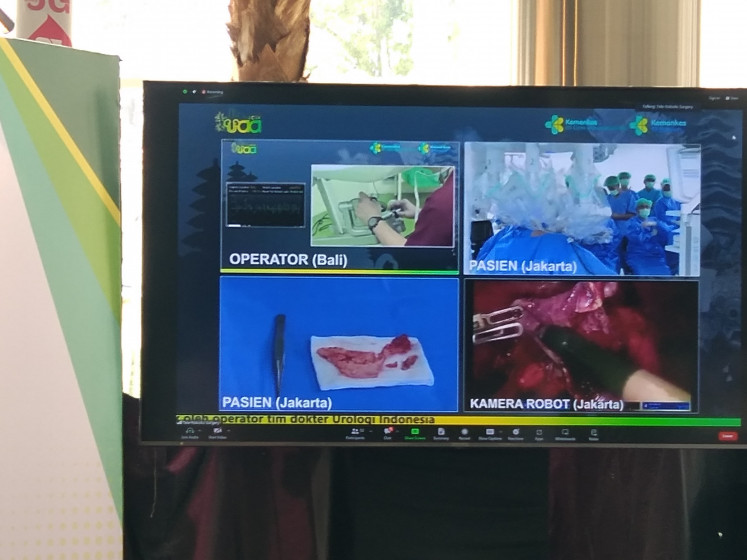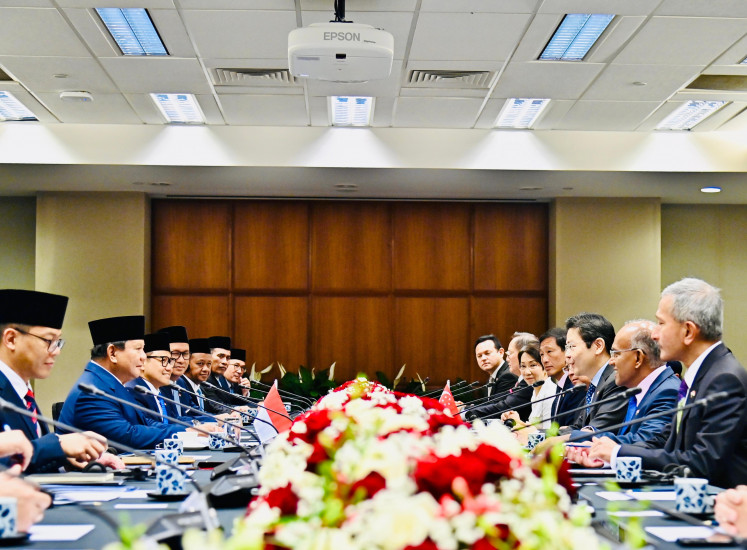Popular Reads
Top Results
Can't find what you're looking for?
View all search resultsPopular Reads
Top Results
Can't find what you're looking for?
View all search resultsA peek into Chinese medicine and cures
In town, a great number of Chinese herbal shops are located in the old town of Glodok in West Jakarta
Change text size
Gift Premium Articles
to Anyone

I
n town, a great number of Chinese herbal shops are located in the old town of Glodok in West Jakarta.
At least 10 herbal shops can be found along Jl. Pancoran Raya. Others, like the popular Toko Obat Karti Djaja store – which used to be known as Hok Seng Tong — are located on Jl. Kemenangan. Dozens of stalls selling various remedies can also be found inside the Chandra Building Shopping Center in Glodok.
Most herbs shops are open from 10 a.m. to around 6 p.m. Lunch time is the busiest hour of the day.
Inside, most of the herbal shops provide numerous Chinese medicines in modern packaging as well as freshly mixed herbs, which requires exact
measurements.
In the Ban Seng drug store on Jl. Pancoran Raya, some buyers come with their prescriptions, asking a man behind a counter to prepare their herbal remedies.
As one man exited from a room in the back of the store, a pair of senior citizens walked in.
“They’re meeting our sinshe [Chinese traditional healer] inside,” Liman, who is one of the shop’s herbal mixers, told The Jakarta Post.
The shop, which architecture is not very Chinese, but a clean, well-lighted place. Its openness welcomes visitors looking for herbal cures or sightseers just passing by.
Liman said that the shop, which has been open since 1933, offered various remedies, whether mixed on site or pre-packaged. “Starting from the simplest ailments, such as masuk angin [colds] and pegel linu [body aches] to serious illnesses, such as cancer.”
Liman said that all the medicines sold by the shop were made by the shinshe.
“When a patient comes in without knowing what kind of medication she or he needs, we advise this person to meet our healer,” he says.
“After a consultation, which costs Rp 50,000 [US$5] per session, a person will get a prescription from the healer and give it to us. We will make the cure based on the prescription.”
Liman said that consuming the mixed medicine was like drinking a cup of tea. “You boil it down in water for a few minutes. When it’s done, you take the water and drink it up — it’s as simple as that.”
Although he knew about the detailed usage of all of the herbal ingredients and curative plant roots on sale at the store, including ginseng imported from China, Liman declined to discuss the cures in detail. “I think that the best way to know about the herbs is directly from the shinshe,” Liman said.
The store also accepted prescriptions from any shinshe, not just the store’s in-house healer. “The prescription is valid for as long as it is still suitable for a patient. We can always mix the herbs for them.”
Tuti, a resident of Bumi Serpong Damai in Tangerang, said that she came to Ban Seng for two kinds of herbal pills, which she bought by box.
“The first is for my mother, who has diabetes. I’ve been buying this diabetes medicine for a couple of years now. I always send them to my mother in Purbalingga [Central Java],” Tuti said.
She said that she got the prescription, which was just on a small piece of paper, from another healer.
Tuti said that she didn’t know the name of the medicine that she was purchasing, which came packaged in a blue paper box with Chinese letters that was about the size of a deck of cards. “I just recognize the box.”
The second medicine came in a red hexagonal plastic package.
“It also contains pills. It’s for my son, who just got into an accident. It somehow helps to dry up his injuries pretty quickly. It’s been good after all,” Tuti said.
In another busy herbal shop, Tay Seng Hoo, the Chinese ambiance was thicker.
The shop is hidden behind sidewalk vendors and a white trellis, leaving just space just big enough to squeeze through. There were two nearly obscured signs in front of the shop, informing potential patrons that the store was licensed but it did not accept outside prescriptions. It wasn’t clear, however, which institution issued
the store its license.
Inside, the shop featured wooden furniture, from its counter — which was used to mix the prescribed herbs — to display cabinets.
The shop was centered around a huge board with dark red Chinese letters, making you feel as if you passed into the 1930s when crossing the store’s threshold. There was, however, a small but significant proof of modernity: The shop was equipped with air conditioner.
About a half dozen customers awaited patiently on wooden stools adjacent to the counter, talking to each other while watching the mixers at work. Others labored hectically in the back of the shop.
One patron, Aling, was diagnosed with an endometrial tumor for which she has had several operations.
“It [the tumor] just returned. My doctor said that I have another one, so I decided to also take Chinese herbs as an alternative treatment alongside the medical approach,” Aling told the Post.
Aling, who is in her thirties, said that it was her first time at the Chinese herbal medicine shop in Glodok.
“I don’t know whether it’s going to work or not. The healer I met earlier even said that were no definite positive results from herbal treatment, but I’m just doing the best for my health,” she said.
Aling said that her prescription took the form of a herbal concoction that needed to be boiled in water before consumption.
Like Tuti, Aling did not know the exact name of her cure, choosing to put her faith in the shinshe, who wrote her prescription in Chinese letters that she could not read herself.
For the first round of treatment, Aling bought a 10-day supply of medicine that set her back Rp 500,000. She said that she would go for a checkup after finishing the remedy at home.
“We’ll see if they have any effect. I really hope so,” Aling says. “I’ve heard that Chinese medicines can bring good news.”









